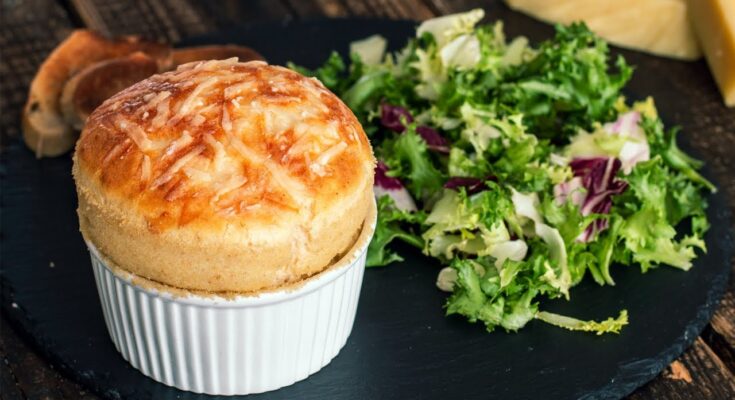Cheese Souffle Recipe: There’s something magical about a well-made cheese soufflé. That golden, puffed-up dome rising proudly in the oven—airy, cheesy, and impossibly elegant. While the word “soufflé” might sound intimidating, the truth is, with the right steps and a bit of patience, you can whip one up in your own kitchen without breaking a sweat. In this ultimate step-by-step guide, we’ll walk you through exactly how to make a cheese soufflé that not only rises beautifully but tastes like it came straight out of a French bistro.
Whether you’re cooking for a romantic dinner, impressing guests, or simply treating yourself to a luxurious snack, this cheese soufflé recipe will deliver flavor, drama, and satisfaction. Let’s dive right in!
What is a Cheese Soufflé?
A cheese soufflé is a light, fluffy dish made primarily with eggs and cheese. The name “soufflé” comes from the French verb souffler, meaning “to blow” or “to puff,” and that’s exactly what a good soufflé does in the oven—it puffs up dramatically thanks to air whipped into egg whites. The base is typically a creamy, seasoned béchamel sauce mixed with cheese and egg yolks. This mixture is then gently folded with stiffly beaten egg whites, which give the soufflé its trademark lift.
Think of it as a cheesy cloud with a crisp top and a soft, custardy center. It’s delicate, yet intensely flavorful. While it might have a reputation for being temperamental, the reality is that if you follow the method closely, it’s actually quite forgiving.
Why Try Making a Cheese Soufflé at Home?
You might be wondering, “Why go through the trouble of making a soufflé when I can just make mac and cheese?” And hey, mac and cheese is delicious, but a soufflé offers something entirely different—it’s light, airy, elegant, and just plain impressive.
Here’s why it’s worth making at home:
- It’s a showstopper. Guests will be amazed when you pull this golden masterpiece out of the oven.
- It’s surprisingly simple. Once you understand the steps, it’s mostly just whisking and folding.
- It uses basic ingredients. Eggs, milk, cheese, flour—but the result tastes gourmet.
- It’s versatile. You can play with cheeses, add herbs, spices, or even bits of ham or mushrooms.
- It’s a lesson in technique. Making a soufflé teaches you core kitchen skills like making a roux, beating egg whites, and folding.
Bottom line: it’s the kind of dish that makes you feel like a real chef, even if you’re just in your socks on a Sunday morning.
What Makes a Soufflé Rise? The Secret Behind the Puff
Here’s where the kitchen science kicks in. The rise of a soufflé is all thanks to air. More specifically, it’s the air trapped in the whipped egg whites that expands in the oven’s heat. That trapped air lifts the whole mixture, causing it to puff up dramatically.
The key points:
- Whipping egg whites incorporates air and structure.
- Cream of tartar or lemon juice helps stabilize the whites so they hold their shape.
- Folding gently ensures you don’t deflate the whites while combining them with the base.
- Oven temperature matters—a hot oven gives that initial lift.
Skip one of these steps, and your soufflé might fall flat—literally.
Essential Tools & Equipment for a Perfect Soufflé
You don’t need a fancy kitchen to make a soufflé, but a few essential tools will make the process smoother and more foolproof.
Must-haves:
- Ramekins (6 oz or 8 oz): These are small ceramic dishes perfect for individual soufflés.
- Electric mixer or hand whisk: You’ll need it to whip the egg whites stiff.
- Saucepan: For making your béchamel base.
- Rubber spatula: For folding without deflating.
- Measuring cups and spoons
- Baking tray: Makes it easier to move ramekins in and out of the oven.
- Pastry brush (optional): For greasing ramekins precisely.
Having these tools at the ready will make your soufflé-making smoother, cleaner, and more consistent.
Ingredients You’ll Need
Let’s get to the good stuff: what you actually need to make your cheese soufflé. These ingredients are pantry-friendly, but the magic lies in how you combine them.
Main Ingredients:
- 2 tablespoons (30g) unsalted butter (plus more for greasing ramekins)
- 2 tablespoons (15g) all-purpose flour
- 1 cup (240ml) whole milk, warm
- 1/2 teaspoon salt
- 1/4 teaspoon freshly ground black pepper
- 1/4 teaspoon nutmeg (optional)
- 1 cup (100g) grated Gruyère cheese (or cheddar, or mix of cheeses)
- 4 large eggs, separated (yolks and whites in different bowls)
- 1/4 teaspoon cream of tartar (optional, helps stabilize egg whites)
- 2 tablespoons grated Parmesan (for ramekin coating)
Optional Flavor Enhancers:
- A pinch of cayenne for heat
- A teaspoon of Dijon mustard for depth
- Finely chopped chives or thyme
- Cooked and crumbled bacon or pancetta
- A hint of smoked paprika
Customize your soufflé to match your mood or meal—just don’t overload it or it might not rise properly.
Choosing the Right Cheese for Your Soufflé
Cheese is the heart and soul of your soufflé, so choose wisely. You want a cheese that melts smoothly and brings bold flavor without overpowering the dish.
Best cheese choices:
- Gruyère: Nutty, slightly salty, melts beautifully.
- Aged Cheddar: Sharp and tangy, adds depth.
- Comté: Similar to Gruyère, with a more complex aroma.
- Parmesan: Great as a supporting cheese for an umami punch.
- Fontina: Buttery and creamy.
Tip: Use a mix of cheeses for layered flavor. For example, combine Gruyère for melt, cheddar for sharpness, and a little Parmesan for bite.
Avoid cheeses that are too watery (like fresh mozzarella) or too soft (like brie) unless you know how to adjust the base.
Preparing Your Ramekins Like a Pro
This step is crucial and often overlooked by beginners. How you prepare your ramekins directly affects how well your soufflé rises and whether it clings to the sides during baking. If you want that classic tall, puffed-up top, don’t skip this.
Here’s how to do it:
- Butter Generously: Use room temperature butter and a pastry brush (or your fingers) to coat the inside of each ramekin. Be sure to brush in upward strokes. This helps guide the soufflé upward as it rises.
- Dust with Parmesan or Breadcrumbs: After buttering, sprinkle in grated Parmesan or dry breadcrumbs. Rotate and tap the ramekin to make sure the coating sticks to every inch of the butter. This adds flavor and creates a textured surface the soufflé can climb.
- Chill the Ramekins: Pop the ramekins into the fridge while you prepare the batter. This keeps the butter firm, which helps with even rising later.
Don’t skimp on this part—it’s like building the foundation for a house. Without a strong base, things can collapse.
Step-by-Step Guide to Making the Perfect Cheese Soufflé
Now we’re getting into the heart of the recipe. This is where precision meets patience. Follow these steps closely and you’ll get that beautiful, golden, sky-high soufflé every time.
Step 1: Preheat and Prep
Preheat your oven to 375°F (190°C). Butter the inside of your soufflé dish, then coat it with grated Parmesan or breadcrumbs—this helps the soufflé rise evenly.
Step 2: Make the Béchamel Sauce
In a saucepan, melt 2 tablespoons of butter, whisk in 2 tablespoons of flour, and cook for 1 minute. Gradually whisk in 1 cup of warm milk until smooth and thickened. Remove from heat.
Step 3: Add Cheese and Seasoning
Stir in 1 cup of grated Gruyère or cheddar cheese, a pinch of nutmeg, salt, and pepper. Add 3 egg yolks one at a time, whisking quickly to avoid scrambling.
Step 4: Whip Egg Whites to Perfection
In a clean bowl, beat 4 egg whites until stiff peaks form—this gives the soufflé its airy lift.
Step 5: Fold Gently, Don’t Stir
Gently fold the whites into the cheese mixture using a spatula. Keep it light and fluffy.
Step 6: Pour and Bake
Pour into the prepared dish and bake for 25–30 minutes until golden and puffed. Serve immediately—beautifully risen, creamy, and delicate.
Troubleshooting Common Soufflé Mistakes
Even experienced cooks run into hiccups with soufflés. Here’s how to handle the most common issues:
| Problem | Possible Cause | Fix |
|---|---|---|
| Didn’t rise | Egg whites not whipped properly or overmixed | Use clean tools and fold gently |
| Collapsed instantly | Overbaked or underbaked | Don’t open oven early, and check jiggle at 20 minutes |
| Grainy texture | Cheese not fully melted | Use finely grated cheese and stir while hot |
| Soggy bottom | Undercooked center | Add 2-3 more minutes baking time, check oven temp |
Practice makes perfect—don’t be discouraged!
Tips to Get the Perfect Rise Every Time
Want your soufflé to rise like a pro’s? Follow these golden rules:
- Room temp eggs are easier to whip.
- Warm milk integrates smoothly into the roux.
- Butter and coat ramekins well. Give the batter something to cling to.
- Don’t open the oven during baking—let it puff in peace.
- Serve immediately. A soufflé starts to fall within minutes of leaving the oven.
Master these, and you’ll never fear the word “soufflé” again.
How to Serve Cheese Soufflé (Presentation Ideas)
Presentation matters. A soufflé is visual drama, and you want it to shine:
- Serve in the ramekin: Place it on a small plate with a cloth napkin underneath to prevent sliding.
- Top with a sprinkle of chives or extra cheese right after baking.
- Add a side salad: A lightly dressed arugula or mixed greens salad balances the richness.
Avoid flipping them out or unmolding—it’s meant to be eaten straight from the dish. That crispy edge and creamy middle? Best experienced with a spoon, straight in.
What to Serve with a Cheese Soufflé? (Side Dish Pairings)
While a cheese soufflé can absolutely shine on its own, pairing it with the right side dishes can turn it into a well-rounded, memorable meal. The key is balance—since the soufflé is rich and creamy, you’ll want to complement it with fresh, acidic, or light components that refresh the palate between bites.
Perfect Pairing Ideas:
- Crisp Green Salad: A salad with arugula, frisée, or watercress dressed in a tangy vinaigrette cuts through the richness of the cheese. Add thin slices of radish, cherry tomatoes, or even apples for brightness.
- Herb-Roasted Vegetables: Lightly roasted asparagus, green beans, or carrots with olive oil and a squeeze of lemon are perfect. Their earthy flavors add contrast without overpowering the soufflé.
- Tomato-Based Soups: A simple tomato basil soup brings acidity and warmth to the plate. The combination of textures—creamy soufflé and silky soup—is irresistible.
- Crusty Artisan Bread: A slice of sourdough or French baguette is perfect for scooping up any remaining soufflé. Choose something with a good crunch.
- Light Protein: A soufflé can serve as a luxurious starter to grilled chicken, seared scallops, or a poached egg. Just keep portions modest and the seasonings subtle.
- White Wine or Sparkling Beverage: Pair with a dry white wine like Sauvignon Blanc or a sparkling wine to cut the richness and elevate the experience.
It’s all about creating a meal that feels indulgent but balanced. Think of the soufflé as the star performer and the sides as the supporting cast that make it shine even brighter.
Storing and Reheating Leftovers
Let’s be honest: a soufflé is best enjoyed fresh out of the oven. But if you find yourself with leftovers (lucky you!), there are still ways to enjoy them the next day.
Storing:
- Let the soufflé cool to room temperature.
- Cover the ramekin with plastic wrap or transfer to an airtight container.
- Store in the refrigerator for up to 2 days.
Reheating:
- Oven Method:
Preheat your oven to 350°F (175°C). Place the ramekin on a baking tray and cover it loosely with foil. Heat for about 10–12 minutes or until warmed through. - Microwave Method (Not Recommended):
If you’re in a hurry, you can reheat in the microwave, but the texture will suffer—it may become rubbery or collapse entirely.
Pro Tip:
Instead of reheating the soufflé, consider transforming leftovers into a delicious filling for a sandwich or breakfast wrap. It’s cheesy, flavorful, and doesn’t require perfection anymore.
Just know this: while leftovers are still tasty, nothing quite matches the freshly puffed perfection of a soufflé right out of the oven. So serve and savor it hot if you can.
FAQs about Cheese Souffle Recipe
1. Can I freeze cheese soufflé?
Technically, yes—but it’s not ideal. The texture will suffer and the rise won’t be the same when reheated. If you must freeze, bake the soufflé first, let it cool, then freeze in its ramekin. Reheat directly from frozen in a 375°F oven for about 20 minutes.
2. Why did my soufflé collapse?
Soufflés naturally deflate a little after coming out of the oven, but if it completely collapses, the likely culprits are underbeaten egg whites, rough folding, or overbaking. Also, opening the oven door too early can cause a sudden temperature drop, which leads to sinking.
3. Can I use different cheeses?
Absolutely! Feel free to experiment with combinations like cheddar and parmesan, goat cheese with herbs, or blue cheese for bold flavor. Just make sure your cheeses melt well and don’t contain too much moisture.
4. Is a soufflé hard to make for beginners?
Not at all—especially when you follow a clear step-by-step guide like this one. As long as you prepare your ingredients, handle the egg whites carefully, and avoid common mistakes, you’ll be surprised at how approachable a soufflé can be.
5. What’s the ideal oven temperature?
375°F (190°C) is the sweet spot for most cheese soufflés. It’s hot enough to create steam and lift the soufflé, but not so hot that it overcooks the center before the outside sets. Make sure your oven is properly preheated and avoid opening the door early.
Conclusion
Making a cheese soufflé at home might sound like a challenge, but once you get the hang of it, it becomes one of the most satisfying dishes in your culinary toolkit. It’s light, airy, rich, and completely luxurious—with just eggs, milk, cheese, and a little bit of technique, you can create a dish that’s as much a feast for the eyes as it is for the stomach.
Remember: preparation is everything. Treat each step with care—whip those egg whites until they’re glossy and stiff, fold them gently, and most importantly, don’t peek in the oven! When that soufflé rises tall and golden, you’ll understand the hype.
Whether you’re serving it for brunch, dinner, or as a fancy appetizer, a cheese soufflé is always a crowd-pleaser. And now that you know exactly how to master it, you’re just one bake away from wowing your friends, your family, or simply yourself.



